Bad Economic News Catches Up with the Stock Market
Stock-Markets / Stock Markets 2010 Aug 07, 2010 - 05:09 AM GMT Private employment rises less than forecast, prior month hiring revised down.
Private employment rises less than forecast, prior month hiring revised down.
Total nonfarm payroll employment declined by 131,000 in July, and the unemployment rate was unchanged at 9.5 percent, the U.S. Bureau of Labor Statistics reported today. Federal government employment fell, as 143,000 temporary workers hired for the decennial census completed their work. Private-sector payroll employment edged up by 71,000.
The employment-to-population ratio tells a more accurate story than the Bureau of Labor Statistics.
Private payrolls that exclude government agencies rose by 71,000 last month, less than forecast, after a June gain of 31,000 that was smaller than previously reported, Labor Department figures in Washington showed today. Economists projected a 90,000 July increase, according to the median estimate in a Bloomberg News survey.
The Russian Heartland is ablaze.
(Bloomberg) Acrid smoke from forest and peat-bog fires east of Moscow shrouded the city in smoke, causing flight delays and raising pollution to “very dangerous” levels. Emergency crews are battling 558 fires covering 179,596 hectares (693 square miles) across Russia, the Emergency Situations Ministry said on its website today. So far this year, fires have scorched 729,761 hectares, an area about three times the size of Luxembourg, according to the ministry. The fires have killed at least 52 people, the Health Ministry said.
(ZeroHedge) For all those curious to see just what an entire country on fire looks like, the University of Maryland Fire Information for Resource Management Services provides an interactive map of all currently raging fires in Russia.
The bad news catches up with the market.
 --Investment Company Institute reported that domestic equity (stock) funds reported their 13th sequential outflow of $4.1 billion last week. The total Y-T-D outflow now approaches $50 billion, as the current sentiment seems to be saying, “No thanks” to the increased volatility. According to the Financial Times, banks are starting to panic that as a result of collapsing trade volumes, profit target misses and massive layoffs may be just around the corner.
--Investment Company Institute reported that domestic equity (stock) funds reported their 13th sequential outflow of $4.1 billion last week. The total Y-T-D outflow now approaches $50 billion, as the current sentiment seems to be saying, “No thanks” to the increased volatility. According to the Financial Times, banks are starting to panic that as a result of collapsing trade volumes, profit target misses and massive layoffs may be just around the corner.
Treasury bonds get a new lease on life.
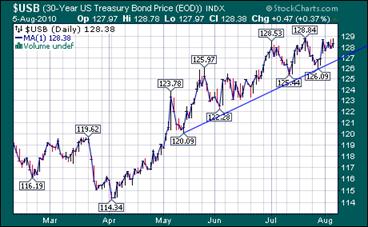 -- Treasury bonds went from a shaky position last week to a new rally, as stocks start to sell off again.
Investors believe that as long as the economy weakens, bonds will strengthen. But the true picture is more complex. Bonds may be a temporary safe haven, but as the leverage unwinds, bonds, which are in the carry trade, will have to be sold at some point as well to raise cash.
-- Treasury bonds went from a shaky position last week to a new rally, as stocks start to sell off again.
Investors believe that as long as the economy weakens, bonds will strengthen. But the true picture is more complex. Bonds may be a temporary safe haven, but as the leverage unwinds, bonds, which are in the carry trade, will have to be sold at some point as well to raise cash.
A rally in gold takes back some losses.
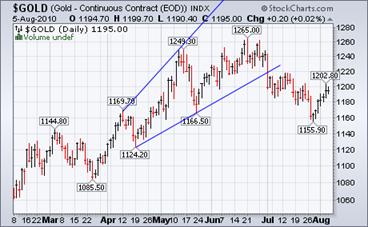 --The continued rally in gold seems to be attributed to the declining dollar. Unfortunately, this relationship may be misplaced, since gold had previously been declining alongside the dollar until the past two weeks. Nonetheless, investors are piling back on to gold in the hopes that the uptrend may resume.
--The continued rally in gold seems to be attributed to the declining dollar. Unfortunately, this relationship may be misplaced, since gold had previously been declining alongside the dollar until the past two weeks. Nonetheless, investors are piling back on to gold in the hopes that the uptrend may resume.
Nikkei rallies on old news.
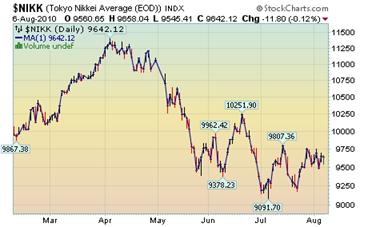 --Japanese stocks had a back-and-forth week as economic cross-currents from the U.S. kept investors guessing about the direction of the economy.
After a hefty gain of 1.7 percent on Thursday, the Nikkei Index almost gave it all back this morning. It’s too bad that the Nikkei was closed by the time bad unemployment news arrived in the U.S.
--Japanese stocks had a back-and-forth week as economic cross-currents from the U.S. kept investors guessing about the direction of the economy.
After a hefty gain of 1.7 percent on Thursday, the Nikkei Index almost gave it all back this morning. It’s too bad that the Nikkei was closed by the time bad unemployment news arrived in the U.S.
The Shanghai index shrugs off banking issues.
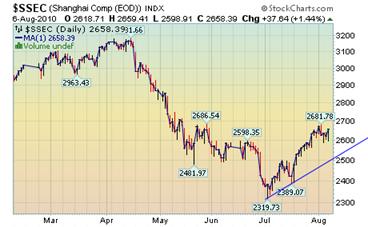 -- China’s stocks rebounded, extending gains for the benchmark index to a third week, as concerns about banks’ stress tests eased and agriculture companies advanced after the worst floods in a decade boosted food prices.
-- China’s stocks rebounded, extending gains for the benchmark index to a third week, as concerns about banks’ stress tests eased and agriculture companies advanced after the worst floods in a decade boosted food prices.
The Shanghai Composite Index, which tracks the bigger of China’s stock exchanges, added 37.64 to 2,658.39 at the close, reversing an earlier 0.8 percent decline.
The dollar continues its decline, but not for long.
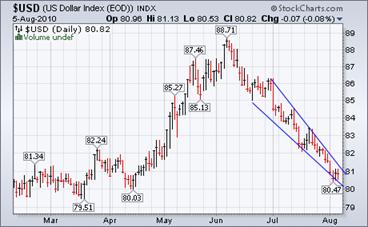 -- The dollar dropped to an eight-month low against the yen and fell versus the euro as data showed the U.S. lost more jobs in July than forecast, adding to concern the economy may need additional stimulus measures.
-- The dollar dropped to an eight-month low against the yen and fell versus the euro as data showed the U.S. lost more jobs in July than forecast, adding to concern the economy may need additional stimulus measures.
The Dollar Index was poised for its ninth straight weekly loss, the longest string since 2004.
Tax credit purchases suggest home prices are still too high.
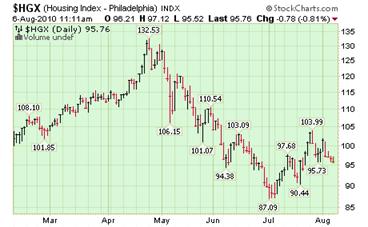 -- Tuesday’s pending home sales report is the latest indicator that the U.S. housing market is bogged down by an inventory problem: Too many houses, not enough buyers.
-- Tuesday’s pending home sales report is the latest indicator that the U.S. housing market is bogged down by an inventory problem: Too many houses, not enough buyers.
Pending sales, signed contracts on the purchase of new homes tracked by the National Association of Realtors, were down 3% in June compared to May. That month saw a 30% drop in the index, after the April 30 expiration of the home buyer’s tax credit.
Gasoline prices are reluctant to decline.
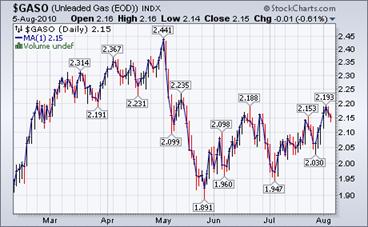 --The Energy Information Agency weekly report observes, “The U.S. average retail price for regular gasoline decreased over one cent to $2.74 per gallon after increasing by almost three cents the previous week. This week’s price is still $0.18 per gallon higher than this time last year. Price changes were mixed throughout the country, with the Midwest seeing the largest price decrease of almost 5 cents to $2.70 per gallon.”
--The Energy Information Agency weekly report observes, “The U.S. average retail price for regular gasoline decreased over one cent to $2.74 per gallon after increasing by almost three cents the previous week. This week’s price is still $0.18 per gallon higher than this time last year. Price changes were mixed throughout the country, with the Midwest seeing the largest price decrease of almost 5 cents to $2.70 per gallon.”
Hot weather keeps natural gas prices aloft.
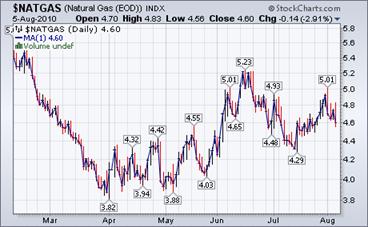 --. The U.S. Energy Information Administration reports, “Summer temperatures engulfed much of the country this week, with continued power demand likely supporting price movements this week in spot markets. The short-lived tropical storm Colin served as yet another reminder of the 2010 Atlantic hurricane season, marking the second tropical storm formation in 3 weeks.”
--. The U.S. Energy Information Administration reports, “Summer temperatures engulfed much of the country this week, with continued power demand likely supporting price movements this week in spot markets. The short-lived tropical storm Colin served as yet another reminder of the 2010 Atlantic hurricane season, marking the second tropical storm formation in 3 weeks.”
Thanks for the Invitation Mr Geithner, But You Forgot to Mention Which Planet You’re On
(ZeroHedge) Tim Geithner recently wrote an Op-Ed piece in the New York Times titled, "Welcome to the Recovery."
The title sort of says it all, but just by skimming over it my immediate conclusion is that Mr. Geithner is either outright insane or a total liar. Neither of those are welcome realizations, though I doubt they are news to anyone with a working brain. However, for the sake of manners, I'll simply assume Mr Geithner is outright insane, in which case I am indeed, quite honored to be invited to his recovery... I only wish he'd mentioned the planet where it was taking place.
Let’s have a look at some data points on Earth, courtesy of the Bureau of Labor Statistics.
June 2009 |
June 2010 |
Change |
|
Civilian Labor Force |
154. 7 million |
153.7 million |
-1 million |
People Employed |
140 million |
139.1 million |
-900,000 |
People Unemployed |
14.7 million |
14.6 million |
-100,000 |
People Out of the Workforce |
80.8 million |
83.9 million |
+3.1 million |
People working part-time for economic reasons |
8.9 million |
8.6 million |
-300,000 |
Discouraged Workers |
793,000 |
1.2 million |
+407,000 |
People unemployed 27 weeks of greater |
4.4 million |
6.7 million |
2.3 million |
International Savings Rates Bode Ill for US Markets
(ZeroHedge) Often while searching for a piece of data through Google (see above) I stumble across something else which is far more interesting. That is how I found the table below of international savings rates.
Why should you care? Because countries with high savings rates tend to have strong economies and great stock markets, since there is plenty of excess cash available to pour into investments. Those with low savings rates suffer from weak economies and poor stock markets, because of a shortage of available capital.
IF IT'S NOT A DOUBLE DIP THEN IT'S MR. SOFTEE
(ZeroHedge) Again, U.S. nonfarm payrolls came in weaker than expected, and while some of the components offered up some good news, like a 36,000 rise in manufacturing employment and an uptick in the workweek, the report overall was quite soft. If this were summer school, I’d be tempted to give it a C-minus, and only because after a terrific week vacationing in Chicago, I’m in a generous mood.
The headline came in at -131,000 versus the consensus estimate of -65,000 (private payrolls did rise 71,000 but this was below the 90,000 increase that was widely expected). And, the net revisions to the prior two months was -97,000, so in effect the “level” of employment was 153,000 lower than what the economics community was penning in the for the month. So, the shortfall was even greater than the headline “miss” would suggest, counting in the revisions.
The Establishment survey tends to understate what is happening at the small business level, which is why it is imperative to keep a close eye on the household survey — and employment here contracted 159,000 in July after sliding 301,000 in June and 35,000 in May. Historically, the odds of seeing three whiffs in a row in this survey without the economy either being in a recession or quickly heading into one is 50 to one.
Traders alert: The Practical Investor is currently offering the daily Inner Circle Newsletter to new subscribers. Contact us at tpi@thepracticalinvestor.com for a free sample newsletter and subscription information.
Our Investment Advisor Registration is on the Web
We are in the process of updating our website at www.thepracticalinvestor.com to have more information on our services. Log on and click on Advisor Registration to get more details.
If you are a client or wish to become one, please make an appointment to discuss our investment strategies by calling Connie or Tony at (517) 699-1554, ext 10 or 11. Or e-mail us at tpi@thepracticalinvestor.com .
Anthony M. Cherniawski, President and CIO http://www.thepracticalinvestor.com
As a State Registered Investment Advisor, The Practical Investor (TPI) manages private client investment portfolios using a proprietary investment strategy created by Chief Investment Officer Tony Cherniawski. Throughout 2000-01, when many investors felt the pain of double digit market losses, TPI successfully navigated the choppy investment waters, creating a profit for our private investment clients. With a focus on preserving assets and capitalizing on opportunities, TPI clients benefited greatly from the TPI strategies, allowing them to stay on track with their life goals
Disclaimer: The content in this article is written for educational and informational purposes only. There is no offer or recommendation to buy or sell any security and no information contained here should be interpreted or construed as investment advice. Do you own due diligence as the information in this article is the opinion of Anthony M. Cherniawski and subject to change without notice.
Anthony M. Cherniawski Archive |
© 2005-2022 http://www.MarketOracle.co.uk - The Market Oracle is a FREE Daily Financial Markets Analysis & Forecasting online publication.



